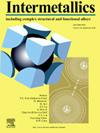Effect of element substitution on hydrogen storage properties of La-Mg-Ni-based alloys prepare by heat treatment
IF 4.3
2区 材料科学
Q2 CHEMISTRY, PHYSICAL
引用次数: 0
Abstract
La-Mg-Ni-based hydrogen storage alloy has become a promising material due to its high hydrogen storage capacity and easy activation. Nevertheless, the use of this alloy system is constrained by its inadequate cycle steadiness, limiting its prospects for widespread commercialisation and industrialisation. In this work, Y and Mn elements with smaller atomic radius are used to partially replace La and Ni elements with larger atomic radius in La-Mg-Ni-based hydrogen storage alloys, so as to reduce the difference in phase volume between LaMgNi4 phase and La(NiMn)5 phase. Annealing treatment promotes the diffusion of alloying elements, eliminates the segregation of as-cast elements, and homogenizes the spatial distribution of AB2 and AB5 phases in the material matrix, improving its cycle stability. The synergistic effect of the element substitution strategy combined with the annealing process on the hydrogen storage performance of La-Mg-Ni-based alloys was systematically explored, including phase composition, microstructure, kinetic performance, cycling performance, and thermodynamic performance. The research findings suggest that the primary phase structure of annealed alloys consists of LaMgNi4 and La(NiMn)5 phases. With the increase of Y substitution, YMgNi4 and Ni3Y phase structures appear. There is a small amount of YH2 phase in the hydrogen storage alloy after dehydrogenation due to the substitution of Y, which is due to the high decomposition temperature of YH2. The Ni3Y phase and YH2 introduce more phase interfaces and boundaries of grains, which enhances the hydrogen uptake and release rates. The as-cast alloy is annealed for a more uniform distribution of elements, and the structure changes from a strip-like dendrite to a cellular crystal. The interphase distribution of the cellular crystal structure provides a good diffusion channel for the migration of hydrogen atoms during the hydrogen absorption/desorption process, which significantly improves the hydrogen absorption rate of the alloy. All annealed hydrogen storage alloys can be fully activated after one hydrogen absorption/desorption cycle. The first activation of Y4 alloy at 373 K temperature only takes 15 min to reach 90 % of the maximum hydrogen absorption capacity, which is nearly 57 % shorter than that of Y0 alloy. The annealed Y4 alloy has a 1.67 wt% hydrogen absorbing ability at 313 K and a 1.26 wt% hydrogen desorption ability at 373 K. With a rise in the replacement of Y elements, the capacity retention rises from 52.21 % to 74.55 % following 50 kinetic cycles of the alloy. The substitution of Y element reduces the phenomenon of crack propagation and pulverization on the surface of the particles during the hydrogen absorption and desorption process, thus significantly improving the cycle stability of La-Mg-Ni-based hydrogen storage alloys. This work shows that the substitution of Y and Mn elements and the annealing process at 1173 K synergistically optimize the hydrogen absorption and desorption kinetics and cycle stability of La-Mg-Ni-based alloys, which provides a feasible strategy for its commercial application.
元素取代对热处理la - mg - ni基合金储氢性能的影响
la - mg - ni基储氢合金因其储氢容量大、易于活化而成为一种很有前途的储氢材料。然而,这种合金系统的使用受到其不充分的循环稳定性的限制,限制了其广泛商业化和工业化的前景。本文采用原子半径较小的Y和Mn元素部分取代La- mg -Ni基储氢合金中原子半径较大的La和Ni元素,以减小LaMgNi4相与La(NiMn)5相的相体积差异。退火处理促进了合金元素的扩散,消除了铸态元素的偏析,使材料基体中AB2和AB5相的空间分布均匀化,提高了循环稳定性。系统探讨了元素替代策略与退火工艺对la - mg - ni基合金储氢性能的协同效应,包括相组成、微观结构、动力学性能、循环性能和热力学性能。研究结果表明,退火合金的初生相组织由LaMgNi4和La(NiMn)5相组成。随着Y取代量的增加,出现了YMgNi4和Ni3Y相结构。由于Y的取代,脱氢后储氢合金中存在少量的YH2相,这是由于YH2的高分解温度造成的。Ni3Y相和YH2引入了更多的相界面和晶界,提高了氢的吸收和释放速率。铸态合金经退火后元素分布更加均匀,组织由条状枝晶变为胞状晶体。胞状晶体结构的相间分布为吸氢/解吸过程中氢原子的迁移提供了良好的扩散通道,显著提高了合金的吸氢率。所有退火贮氢合金经过一次吸氢/脱氢循环后均可完全活化。在373 K温度下,Y4合金的第一次活化只需15 min即可达到最大吸氢量的90%,比Y0合金缩短了近57%。退火后的Y4合金在313 K时的吸氢能力为1.67%,在373 K时的解吸氢能力为1.26%。随着Y元素替换量的增加,经过50次动力学循环后,合金的容量保持率从52.21%提高到74.55%。Y元素的替代减少了吸氢和解吸氢过程中颗粒表面裂纹扩展和粉化现象,从而显著提高了la - mg - ni基储氢合金的循环稳定性。本研究表明,Y和Mn元素的取代和1173 K的退火工艺协同优化了la - mg - ni基合金的吸氢和解吸动力学和循环稳定性,为其商业应用提供了可行的策略。
本文章由计算机程序翻译,如有差异,请以英文原文为准。
求助全文
约1分钟内获得全文
求助全文
来源期刊

Intermetallics
工程技术-材料科学:综合
CiteScore
7.80
自引率
9.10%
发文量
291
审稿时长
37 days
期刊介绍:
This journal is a platform for publishing innovative research and overviews for advancing our understanding of the structure, property, and functionality of complex metallic alloys, including intermetallics, metallic glasses, and high entropy alloys.
The journal reports the science and engineering of metallic materials in the following aspects:
Theories and experiments which address the relationship between property and structure in all length scales.
Physical modeling and numerical simulations which provide a comprehensive understanding of experimental observations.
Stimulated methodologies to characterize the structure and chemistry of materials that correlate the properties.
Technological applications resulting from the understanding of property-structure relationship in materials.
Novel and cutting-edge results warranting rapid communication.
The journal also publishes special issues on selected topics and overviews by invitation only.
 求助内容:
求助内容: 应助结果提醒方式:
应助结果提醒方式:


